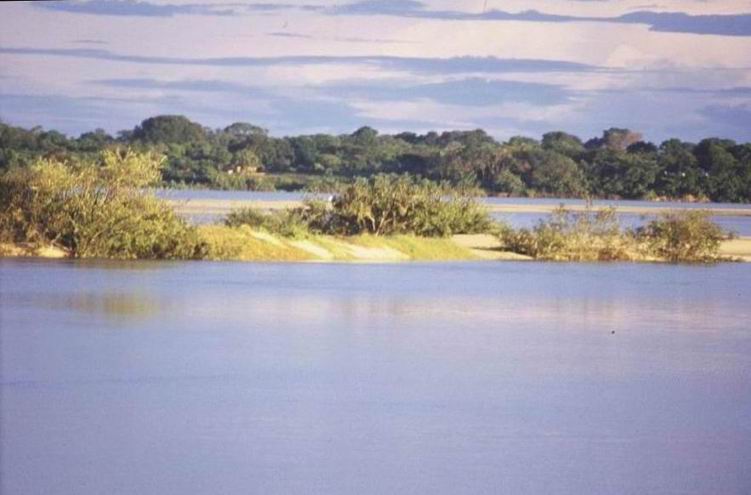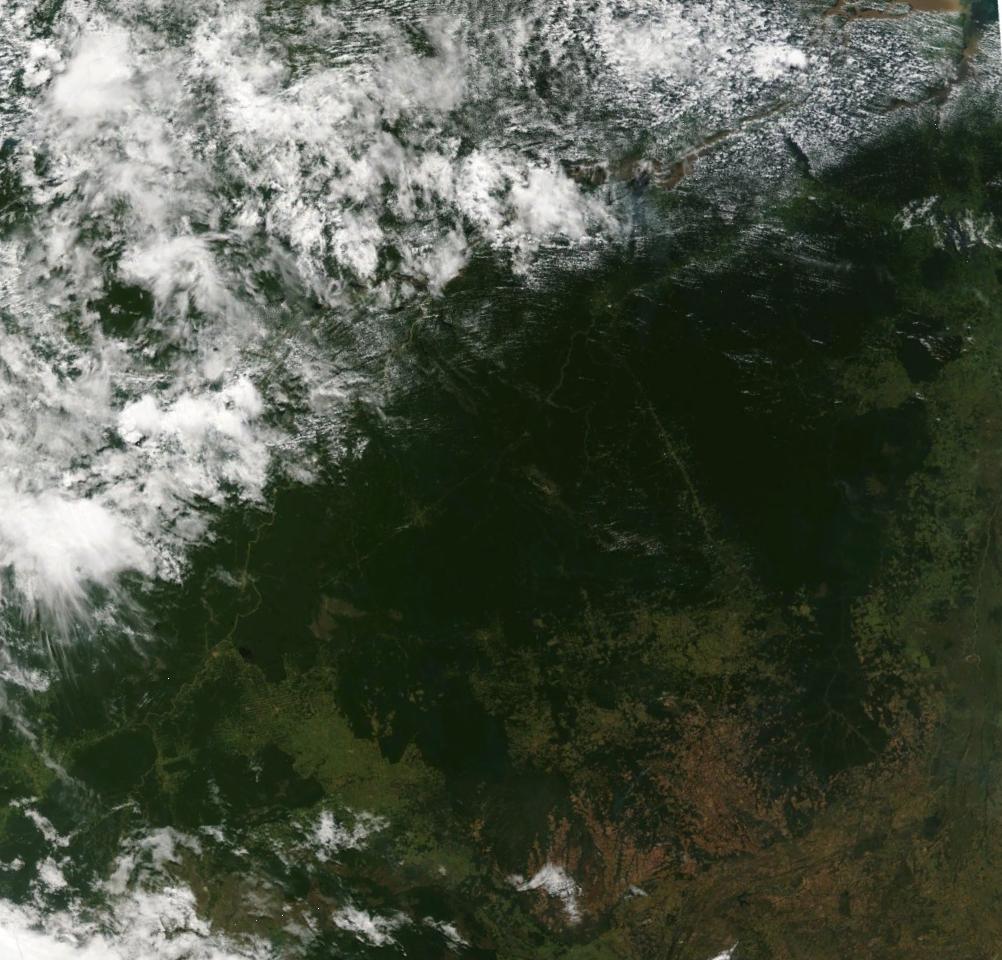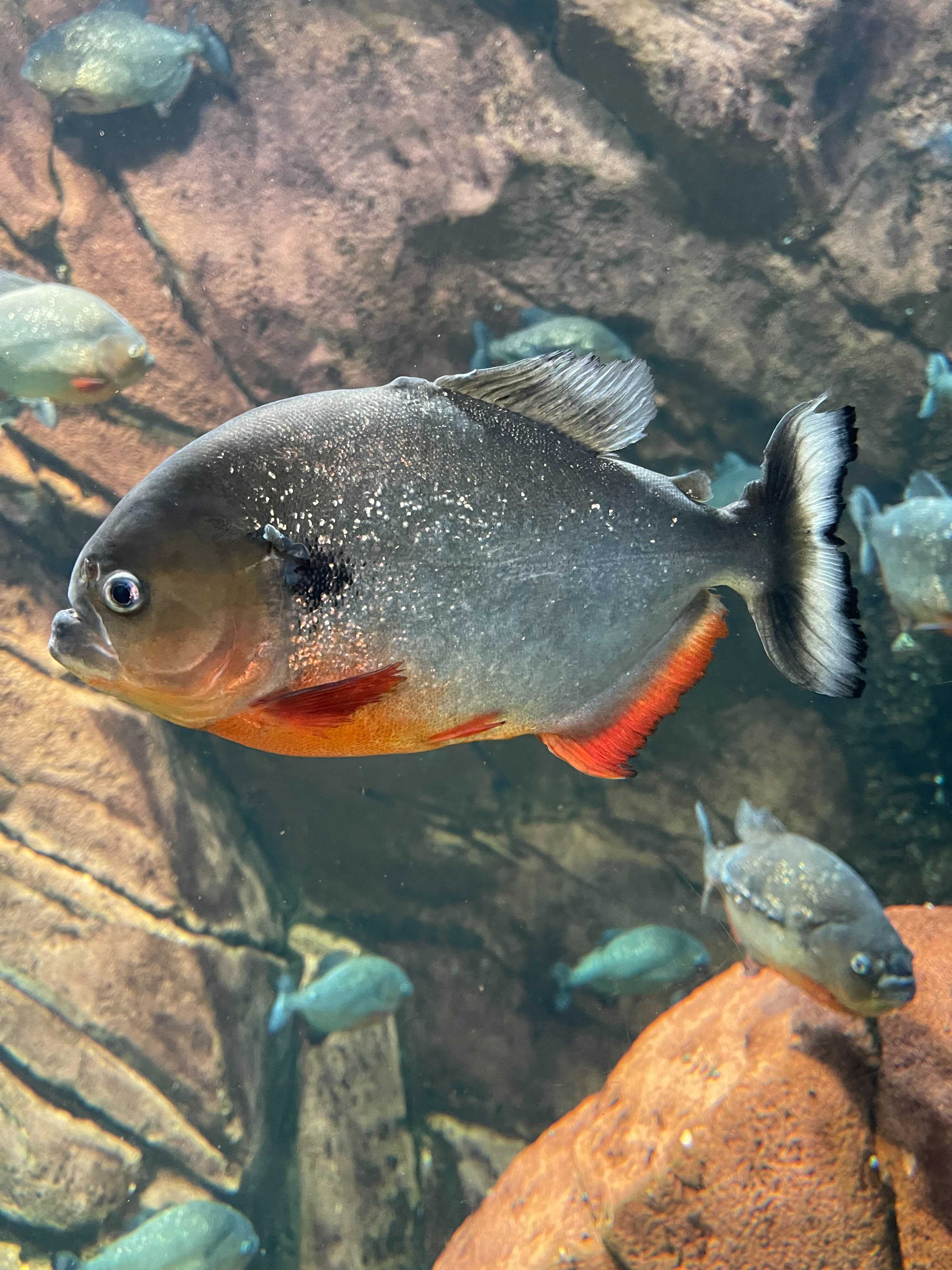|
Cantão
Cantão is a tropical forest ecosystem located in the central Araguaia River, Araguaia river basin, the southeastern edge of the Amazon biome, in the Brazilian state of Tocantins. It is one of the biologically richest areas of the eastern Amazon, with over 700 species of birds, nearly 300 species of fish (more than in all of Europe), and large populations of endangered species such as the giant otter and the black cayman. About 90% of the Cantão ecosystem is protected within Cantão State Park. Ecological importance Due to its geographical location and topography, the Cantão ecosystem combines several unique features that contribute to its high biodiversity and productivity: *It is located at the ecotone between the cerrado and Amazon biomes of Brazil. The cerrado has the highest biodiversity of all the world's savannas, and the Amazon has the highest rainforest diversity. At the Cantão region, this ecotone is particularly sharp, resulting in species from both biomes coexi ... [...More Info...] [...Related Items...] OR: [Wikipedia] [Google] [Baidu] [Amazon] |
Cantão State Park
The Cantão State Park () is a state park in the state of Tocantins, Brazil. It protects the Cantão wetlands, an area of igapó flooded forest in the ecotone where the Amazon rainforest merges into the cerrado. Location The Cantão State Park is located in the municipality of Pium, Tocantins. It has an area of . The park is bounded to the west by the Araguaia River, which forms the border with the state of Pará Pará () is a Federative units of Brazil, state of Brazil, located in northern Brazil and traversed by the lower Amazon River. It borders the Brazilian states of Amapá, Maranhão, Tocantins (state), Tocantins, Mato Grosso, Amazonas (Brazilian st .... The Javaés River separates the state park from the Araguaia National Park to the south. It is bounded by the Ilha do Bananal / Cantão Environmental Protection Area to the east. The park would be in the proposed South Amazon Ecotones Ecological Corridor. History The Cantão State Park was created by state law 996 o ... [...More Info...] [...Related Items...] OR: [Wikipedia] [Google] [Baidu] [Amazon] |
Giant Otter
The giant otter or giant river otter (''Pteronura brasiliensis'') is a South American carnivorous mammal. It is the longest member of the weasel family, Mustelidae, a globally successful group of predators, reaching up to . Atypical of mustelids, the giant otter is a social species, with family groups typically supporting three to eight members. The groups are centered on a dominant breeding pair and are extremely cohesive and cooperative. Although generally peaceful, the species is territorial, and aggression has been observed between groups. The giant otter is diurnal, being active exclusively during daylight hours. It is the noisiest otter species, and distinct vocalizations have been documented that indicate alarm, aggression, and reassurance. The giant otter ranges across north-central South America; it lives mostly in and along the Amazon River and in the Pantanal. Its distribution has been greatly reduced and is now discontinuous. Decades of poaching for its velvety ... [...More Info...] [...Related Items...] OR: [Wikipedia] [Google] [Baidu] [Amazon] |
Araguaia River
The Araguaia River ( , Karajá language, Karajá: ♂ ''Berohokỹ'' [beɾohoˈkə̃], ♀ ''Bèrakuhukỹ'' [bɛɾakuhuˈkə̃]) is one of the major rivers of Brazil, and a tributary of the Tocantins River. Geography The Araguaia River comes from Goiás-Mato Grosso south borders. From there it flows northeast to a junction with the Tocantins River, Tocantins near the town of São João. Along its course, the river forms the border between the states of Goiás, Mato Grosso, Tocantins and Pará. Roughly in the middle of its course the Araguaia splits into a fork (with the western stream retaining the name Araguaia and the eastern one being called the Javaés River). These later reunite, forming the Ilha do Bananal, the world's largest river island. The vein of the Javaés forms a broad inland where it pours back into the main Araguaia, a 100,000 hectare expanse of igapós or flooded forest, blackwater river channels, and oxbow lakes called Cantão, protected by the Cantão State Par ... [...More Info...] [...Related Items...] OR: [Wikipedia] [Google] [Baidu] [Amazon] |
Igapó
(, from Tupi language, Old Tupi: "root forest") is a word used in Brazil for Blackwater river, blackwater-flooded forests in the Amazon biome. These forests and similar swamp forests are seasonally inundated with freshwater. They typically occur along the lower reaches of rivers and around freshwater lakes. Freshwater swamp forests are found in a range of climate zones, from Boreal ecosystem, boreal through Temperate climate, temperate and subtropical to tropical. In the Amazon Basin of Brazil, a seasonally Whitewater river (river type), whitewater-flooded forest is known as a várzea forest, várzea, which is similar to in many regards; the key difference between the two habitats is in the type of water that floods the forest. Characteristics is primarily characterized by seasonal inundation caused by abundant rainfall; in some areas, trees can be submerged for up to 6 months of the year. These ecosystems are relatively open and feature over 30% Canopy (biology), canopy cover ... [...More Info...] [...Related Items...] OR: [Wikipedia] [Google] [Baidu] [Amazon] |
Tocantins
Tocantins () is one of the 26 states of Brazil. It is the newest state, formed in 1988 and encompassing what had formerly been the northern two-fifths of the state of Goiás. Tocantins covers and had an estimated population of 1,496,880 in 2014. Construction of its capital, Palmas, began in 1989; most of the other cities in the state date to the Portuguese colonial period. With the exception of Araguaína, there are few other cities with a significant population in the state. The government has invested in a new capital, a major hydropower dam, railroads and related infrastructure to develop this primarily agricultural area. The state has 0.75% of the Brazilian population and is responsible for 0.5% of the Brazilian GDP. Tocantins has attracted hundreds of thousands of new residents, primarily to Palmas. It is building on its hydropower resources. The Araguaia and Tocantins rivers drain the largest watershed that lies entirely inside Brazilian territory. The Rio Tocantins ... [...More Info...] [...Related Items...] OR: [Wikipedia] [Google] [Baidu] [Amazon] |
Lago Grande
__NOTOC__ Lago, which means "lake" in several languages, may refer to: Places *Lago, Calabria, a ''comune'' in the Province of Cosenza, Italy * Lago, Mexico, a municipality zone in the State of Mexico *Lago District, a ''distrito'' in Niassa Province, Mozambique *Lago, Portugal, a ''freguesia'' in the District of Braga *Lago, Asturias, a ''parroquia'' in the ''municipio'' of Allande, Spain *Lago, Texas, a census-designated place People * Anders Lago (born 1956), Swedish politician *Ângela Lago (1945–2017), Brazilian children's writer and illustrator *Antonio Lago (1893–1960), Venice-born French motor vehicle manufacturer *Enrique Lago, Chilean Anglican bishop *Fábio Lago (born 1970), Brazilian actor *Mario Lago (1878–1950), Italian statesman and diplomat *Mário Lago (1911–2002), Brazilian lawyer, poet, broadcaster, composer and actor *Nais Lago (born 1914), Italian actress *Virginia Lago (born 1946), Argentine actress Other uses *Lago (Madrid Metro), a stat ... [...More Info...] [...Related Items...] OR: [Wikipedia] [Google] [Baidu] [Amazon] |
Coati
Coatis (from Tupí), also known as coatimundis (), are members of the family Procyonidae in the genera '' Nasua'' and '' Nasuella'' (comprising the subtribe Nasuina). They are diurnal mammals native to South America, Central America, Mexico, and the Southwestern United States. The name "coatimundi" comes from the Tupian languages of Brazil, where it means "lone coati". Locally in Belize, the coati is known as "quash". Physical characteristics Adult coatis measure from head to the base of the tail, which can be as long as their bodies. Coatis are about tall at the shoulder and weigh between , about the size of a large house cat. Males can become almost twice as large as females and have large, sharp canine teeth. The measurements above relate to the white-nosed and South America coatis. The two species of mountain coati are smaller. All coatis share a slender head with an elongated, flexible, slightly upturned nose, small ears, dark feet, and a long non-prehensile tail use ... [...More Info...] [...Related Items...] OR: [Wikipedia] [Google] [Baidu] [Amazon] |
Piranha
A piranha (, or ; ) is any of a number of freshwater fish species in the subfamily Serrasalminae, of the family Serrasalmidae, in the order Characiformes. These fish inhabit South American rivers, floodplains, lakes and reservoirs. Although often described as extremely predatory and mainly feeding on fish, their dietary habits vary extensively, and they will also take plant material, leading to their classification as omnivorous. Etymology The name originates from Old Tupi '' pirãîa'', being first attested in the 1587 treatise ' by Portuguese explorer Gabriel Soares de Sousa. ''Piranha'' first appears in 1869 in English literature, likely borrowed from Portuguese. Taxonomy and evolution Piranhas belong to the family Serrasalmidae, which includes closely related omnivorous fish such as pacus. Traditionally, only the four genera '' Pristobrycon'', '' Pygocentrus'', '' Pygopristis'', and '' Serrasalmus'' are considered to be true piranhas, due to their specialized teeth. H ... [...More Info...] [...Related Items...] OR: [Wikipedia] [Google] [Baidu] [Amazon] |
Band-tailed Antbird
The band-tailed antbird (''Hypocnemoides maculicauda'') is a species of bird in subfamily Thamnophilinae of family Thamnophilidae, the "typical antbirds". It is found in Bolivia, Brazil, Colombia, and Peru.Remsen, J. V., Jr., J. I. Areta, E. Bonaccorso, S. Claramunt, G. Del-Rio, A. Jaramillo, D. F. Lane, M. B. Robbins, F. G. Stiles, and K. J. Zimmer. Version 4 March 2024. Species Lists of Birds for South American Countries and Territories. https://www.museum.lsu.edu/~Remsen/SACCCountryLists.htm retrieved 5 March 2024 Taxonomy and systematics The band-tailed antbird was described by the Austrian ornithologist August von Pelzeln in 1868 and given the binomial name ''Hypocnemis maculicauda''.; it was later transferred to genus ''Hypocnemoides''. It shares that genus with the black-chinned antbird (''H. melanopogon''). However, some authors have said that the " asons for treatment of ''Hypocnemoides maculicauda'' as a separate species from ''H. melanopogon'' are weak".Remsen, J. ... [...More Info...] [...Related Items...] OR: [Wikipedia] [Google] [Baidu] [Amazon] |
Black-striped Capuchin
The black-striped capuchin (''Sapajus libidinosus''), also known as the bearded capuchin, is a New World monkey in the family Cebidae. They can be found in northern and central Brazil. These capuchins mostly live in dry forests, and savannah landscapes between the Rio Araguaia and the Rio Grande. Known for its tool use, the black-striped capuchin has been shown to use tools in a wide variety of situations, ranging from using rocks for nut cracking to using sticks for digging. They were, until recently, considered a subspecies of the tufted capuchin, but because of more research and insights, they are considered their own species by many. They often live in highly social groups ranging from 6-20 individuals. Females are philopatric, show coalition, and linear dominance hierarchy In the zoological field of ethology, a dominance hierarchy (formerly and colloquially called a pecking order) is a type of social hierarchy that arises when members of animal social animal, social gro ... [...More Info...] [...Related Items...] OR: [Wikipedia] [Google] [Baidu] [Amazon] |
Orchids
Orchids are plants that belong to the family Orchidaceae (), a diverse and widespread group of flowering plants with blooms that are often colourful and fragrant. Orchids are cosmopolitan plants that are found in almost every habitat on Earth except glaciers. The world's richest diversity of orchid genera and species is in the tropics. Orchidaceae is one of the two largest families of flowering plants, the other being the Asteraceae. It contains about 28,000 currently accepted species in 702 genera. The Orchidaceae family encompasses about 6–11% of all species of seed plants. The largest genera are ''Bulbophyllum'' (2,000 species), ''Epidendrum'' (1,500 species), ''Dendrobium'' (1,400 species) and '' Pleurothallis'' (1,000 species). It also includes ''Vanilla'' (the genus of the vanilla plant), the type genus '' Orchis'', and many commonly cultivated plants such as '' Phalaenopsis'' and '' Cattleya''. Moreover, since the introduction of tropical species into cultivation ... [...More Info...] [...Related Items...] OR: [Wikipedia] [Google] [Baidu] [Amazon] |





